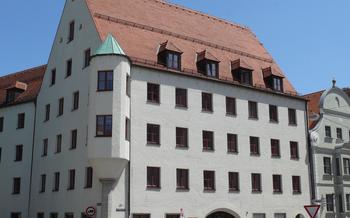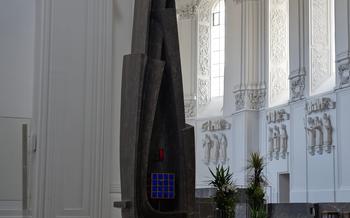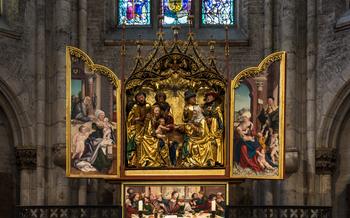
Minoritenkirche
- Regensburg's Captivating Past
- Exploring the Minoritenkirche
- Immerse in Regensburg's Artistic Heritage:
- Unveiling the Gothic Masterpiece
- A Haven of Tranquility
- Step Back in Time
- A Space for Community
- Witness the Living History
- Captivated by Stained Glass: A Symphony of Light and Color
- The Enduring Legacy of the Franciscans
- A Journey Through Time
- A Place of Pilgrimage
- Insider Tip: Unveiling a Hidden Gem
Regensburg's Captivating Past
Regensburg, a city steeped in history, boasts a rich tapestry of architectural wonders that reflect its storied past. Among these gems, the Minoritenkirche stands as a testament to the city's significance and the enduring legacy of the Franciscan order. Built in the 13th century, this Gothic masterpiece played a pivotal role in Regensburg's religious and cultural life. The Minoritenkirche's architectural grandeur and intricate details showcase the city's status as a UNESCO World Heritage Site, while its historical significance is interwoven with the city's rise to prominence as a trading hub and ecclesiastical center.
Over the centuries, the Minoritenkirche witnessed countless events that shaped Regensburg's destiny. From the imperial diets held within its walls to the pilgrims who sought solace and guidance, the church has served as a stage for both secular and spiritual dramas. Its Gothic spires, reaching towards the heavens, symbolize the enduring spirit of a city that has weathered the storms of time, preserving its rich heritage for generations to come.
Exploring the Minoritenkirche
Situated in the heart of Regensburg's Old Town, near the banks of the Danube River, the Minoritenkirche is conveniently accessible on foot or by public transportation. Its impressive Gothic facade, characterized by intricate carvings and pointed arches, immediately captures the attention of visitors. The church's interior, designed in the late Gothic style, boasts a breathtaking array of stained glass windows, each depicting biblical scenes with vibrant colors and meticulous detail. Intricate carvings adorn the walls and pillars, adding to the church's rich visual tapestry. The Minoritenkirche is a testament to the architectural prowess of the Gothic era, showcasing its distinct features, such as ribbed vaults and flying buttresses, which contribute to its awe-inspiring grandeur.
Immerse in Regensburg's Artistic Heritage:
The Minoritenkirche stands as a testament to Regensburg's rich artistic heritage, showcasing a remarkable collection of artwork that spans centuries. Admire the vibrant paintings that adorn the walls, each narrating biblical tales with exquisite detail and vivid colors. Gaze upon the intricate sculptures that grace the altars and niches, depicting saints and angels with lifelike expressions and delicate features. Marvel at the stunning murals that cover the ceiling, telling stories of faith, hope, and redemption through their intricate brushstrokes.
Among the notable artworks within the church is the magnificent altarpiece, a masterpiece of Gothic craftsmanship. Its intricate carvings depict scenes from the life of Jesus Christ, surrounded by a chorus of angels and saints. The altarpiece is a testament to the skill and devotion of the medieval artisans who created it, and it remains a focal point of the church's interior.
The Minoritenkirche also boasts a collection of stained glass windows that are considered among the finest examples of the art form in Germany. These luminous windows bathe the interior in a kaleidoscope of colors, casting a mystical glow upon the sacred space. The intricate designs and vibrant hues tell stories from the Bible, inviting visitors to contemplate the divine and the eternal.
Unveiling the Gothic Masterpiece
The Minoritenkirche proudly stands as a testament to the Gothic architectural style, showcasing its intricate details and symbolic elements. As you step inside, your gaze is immediately drawn to the majestic ribbed vaults that soar overhead, creating a sense of awe and grandeur. The pointed arches, a defining characteristic of Gothic architecture, lend a dynamic and graceful touch to the interior space.
Adorning the walls are intricate carvings that depict biblical scenes and figures, inviting you to explore the rich narratives hidden within the stone. Each carving tells a story, adding depth and meaning to the church's sacred atmosphere. The Minoritenkirche is a true masterpiece of Gothic architecture, embodying the essence of this influential artistic movement.
A Haven of Tranquility
Step inside the Minoritenkirche, and you will be enveloped by a sense of peace and serenity. The hushed whispers of visitors and the gentle glow of candlelight create an atmosphere conducive to contemplation and reflection. Escape the hustle and bustle of the city streets and find solace within these sacred walls. Whether you seek a moment of meditation, a quiet space for prayer, or simply a place to gather your thoughts, the Minoritenkirche offers a sanctuary from the outside world. Allow yourself to be enveloped by the tranquility and let the stresses of everyday life melt away.
Step Back in Time
As you step inside the Minoritenkirche, you are transported back in time. The church's well-preserved state and its historical significance create an immersive experience that allows you to connect with the past. Imagine the lives of those who worshipped here centuries ago, their hopes, fears, and aspirations. The walls of the church seem to whisper stories of faith, devotion, and resilience. Feel the continuity of history and culture as you explore this sacred space, a testament to Regensburg's rich heritage.
A Space for Community
The Minoritenkirche serves as a vibrant community hub, fostering social and cultural interactions beyond its religious significance. The church frequently hosts events, concerts, and exhibitions that attract both locals and visitors. These events provide a platform for community members to gather, celebrate their shared heritage, and engage in meaningful discussions. Whether it's a lively music performance, an art exhibition showcasing local talent, or a thought-provoking lecture, the Minoritenkirche offers a welcoming space for people to connect, share ideas, and create lasting memories.
Witness the Living History
Immerse yourself in the vibrant spiritual community of the Minoritenkirche by attending a mass or religious service. Experience the awe-inspiring atmosphere as the church reverberates with the voices of the congregation, the uplifting melodies of the choir, and the solemn tones of the organ. Participate in the rituals and traditions that have been passed down through generations, connecting you to the rich cultural heritage of Regensburg. Through this immersive experience, you'll gain a deeper understanding of the role that faith plays in the lives of the local community and discover the enduring significance of the Minoritenkirche as a spiritual sanctuary.
Captivated by Stained Glass: A Symphony of Light and Color
The Minoritenkirche boasts a magnificent collection of stained glass windows that transform the interior into a kaleidoscope of colors. These exquisite works of art depict biblical scenes and stories, casting a warm and ethereal glow upon the church. The intricate designs and vibrant hues create a sense of awe and wonder, capturing the attention of visitors from all walks of life.
As sunlight streams through the windows, the colors dance and shimmer, creating a mesmerizing spectacle. Each window tells a different story, inviting viewers to immerse themselves in the narratives of saints, prophets, and biblical events. The skillful craftsmanship and attention to detail are evident in every pane, showcasing the artistic mastery of the artisans who created them.
The Minoritenkirche's stained glass windows are not merely decorative elements; they serve a profound purpose. They illuminate the teachings of the church, providing a visual representation of the spiritual and moral lessons that guide the lives of believers. The windows act as a reminder of the divine presence, inspiring visitors to reflect on their faith and seek a deeper connection with the sacred.
Whether you're a history buff, an art enthusiast, or a spiritual seeker, the Minoritenkirche's stained glass windows are a must-see. They are a testament to the enduring power of art and its ability to transcend time and inspire generations.
The Enduring Legacy of the Franciscans
The Minoritenkirche stands as a testament to the enduring legacy of the Franciscan order, a prominent religious group that has shaped the spiritual and cultural landscape of Europe for centuries. Founded by Saint Francis of Assisi in the 13th century, the Franciscans embraced a life of poverty, humility, and service to others. Their influence extended far beyond the church walls, leaving an indelible mark on art, architecture, and society.
Within the Minoritenkirche, the presence of the Franciscans is palpable. The simple and austere design of the church reflects their commitment to humility and detachment from worldly possessions. The beautiful stained glass windows depict scenes from the life of Saint Francis, reminding visitors of his teachings and his love for nature and all living beings.
The Franciscans' emphasis on community and service is also evident in the Minoritenkirche. The church has long been a gathering place for the local community, hosting events, concerts, and exhibitions that bring people together. Visitors can sense the vibrant spiritual energy that permeates the church, a testament to the enduring legacy of the Franciscan order and its commitment to serving the community and fostering human connection.
A Journey Through Time
The Minoritenkirche has stood the test of time, undergoing various transformations and renovations that reflect the changing architectural styles and evolving needs of the community. In the 14th century, the church underwent a significant expansion, adding a spacious choir and side chapels. The 17th century brought about Baroque influences, as evidenced by the intricate stucco decorations and ornate altars that adorn the interior. During the 19th century, the church underwent a Gothic Revival, resulting in the restoration of many of its original features, including the pointed arches and ribbed vaults. These architectural transformations have left an indelible mark on the Minoritenkirche, creating a fascinating blend of styles that tells the story of its rich history.
A Place of Pilgrimage
The Minoritenkirche's spiritual significance extends beyond its role as a local parish church. It has long been a place of pilgrimage, attracting devout individuals seeking solace, inspiration, and a deeper connection with the divine. The church's rich history, beautiful architecture, and sacred atmosphere create a conducive environment for reflection and spiritual growth. Pilgrims from near and far come to experience the tranquility of the church and to seek blessings and guidance.
Some believe that the Minoritenkirche possesses miraculous powers and that prayers offered within its walls are more likely to be answered. Others are drawn to the church's connection to the Franciscan order, renowned for their devotion and compassion. Regardless of their reasons, pilgrims find comfort and spiritual renewal within the Minoritenkirche's sacred space.
The church also hosts special pilgrimage services and events throughout the year, attracting large numbers of faithful. During these events, pilgrims participate in processions, prayers, and other rituals, seeking spiritual guidance and blessings. Whether you are a devout believer or simply seeking a place of peace and tranquility, the Minoritenkirche's pilgrimage tradition offers a unique and enriching experience.
Insider Tip: Unveiling a Hidden Gem
As you explore the Minoritenkirche, keep an eye out for a hidden gem that adds to its allure. Within the church's walls lies a secret passage, accessible through an unassuming door. This passage leads to a secluded chamber, where you'll find a forgotten artwork of remarkable beauty. The piece, a delicate sculpture or an ancient painting, has been preserved in this hidden space, away from the crowds. Discovering this hidden treasure will enhance your visit to the Minoritenkirche, leaving you with a sense of wonder and a deeper appreciation for its secrets.




